Hamamelis spp.
As a witch hazel can attest, timing is everything.
It’s the difference between a world record race and a false start, an epic guitar solo or a botched shred, a successful investment or filing for bankruptcy… and species of Hamamelis have excellent timing in spades.
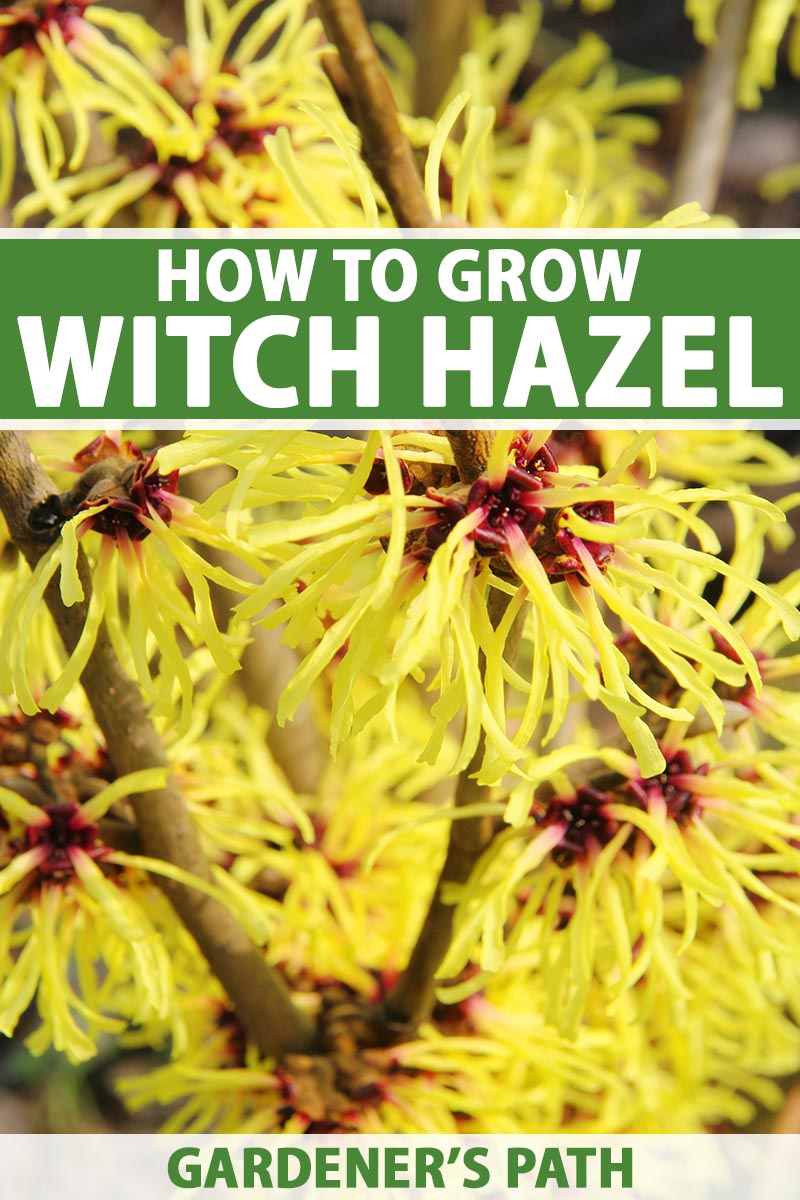
We link to vendors to help you find relevant products. If you buy from one of our links, we may earn a commission.
With super early – or super late – blooms, witch hazel flowers have their own, private slot of time in which to shine.
Along with hogging the gaze of onlookers during an otherwise bleak and bloomless period, the flowers of Hamamelis are the only game in town for pollinating insects, which gives the plant a reproductive edge.
But a witch hazel’s success in cultivation isn’t all thanks to timing – it looks stunning year round.
With lush foliage and an attractive branching habit, there’s always something to appreciate about these shrubs, no matter the season.
A growing guide is in order for the gardener interested in learning more about such a spectacular genus, one that gives you all the info required for growth and care.
Order up:
What You’ll Learn
What Is Witch Hazel?
Belonging to the witch hazel family (Hamamelidaceae) and the Hamamelis genus, witch hazels are five species of deciduous flowering shrubs and – occasionally – small trees, which are collectively hardy to USDA Zones 3 through 9.
Hailing from China, Japan, and North America, Hamamelis plants are renowned for their unique flowers, bloom times outside the norm, and multi-stemmed habits.
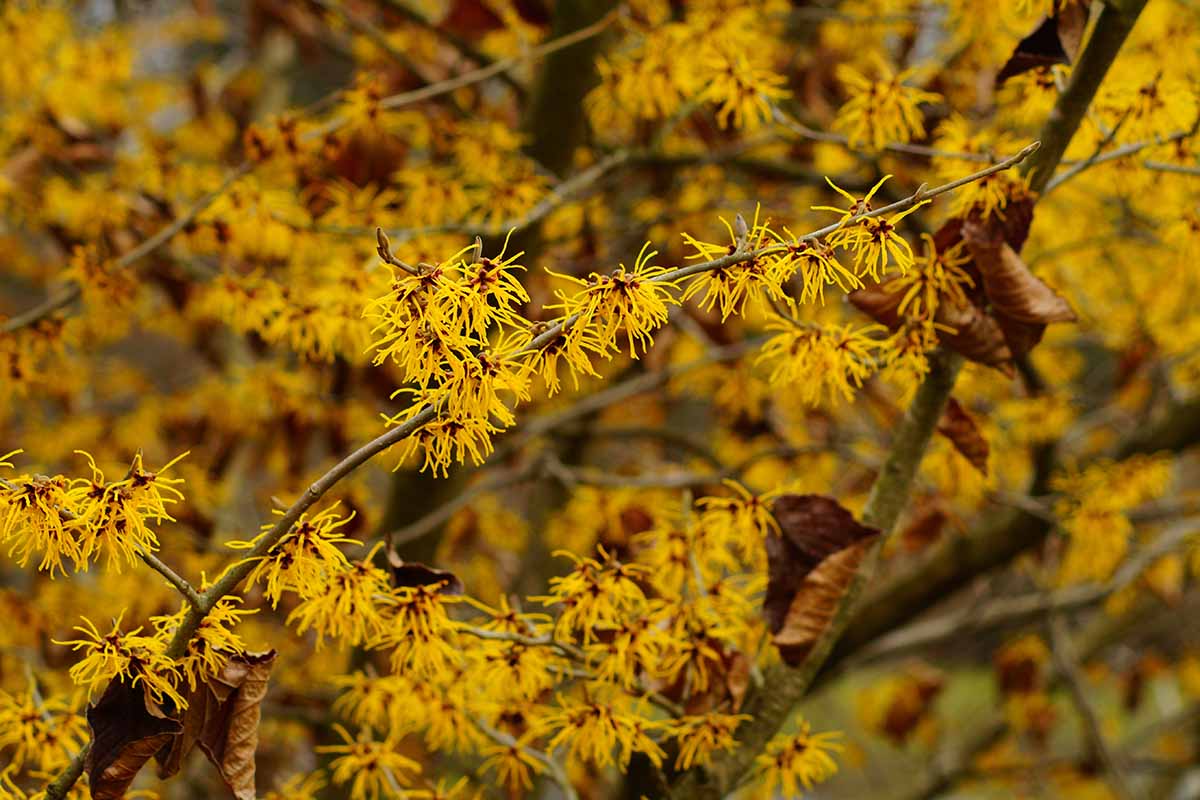
Witch hazels bear clusters of stem-hugging flowers, with each bearing four crinkly, narrow, ribbon-like petals that curl up in cold weather.
Petals vary in color from yellow to brownish red in species plants, while some cultivars flaunt purple petals.
The blooms emerge either in late winter to early spring or in the fall, depending on the variety. But in general, Hamamelis flowers while most other plants are dormant, which gives the plants an aesthetic edge during this time.
Spring-blooming witch hazels are primarily pollinated by flies and wasps, while the fall-flowering blooms are pollinated by winter-flying moths that don’t die off with the arrival of cold weather.
Typically, witch hazels have an annual growth rate of about four to 12 inches.
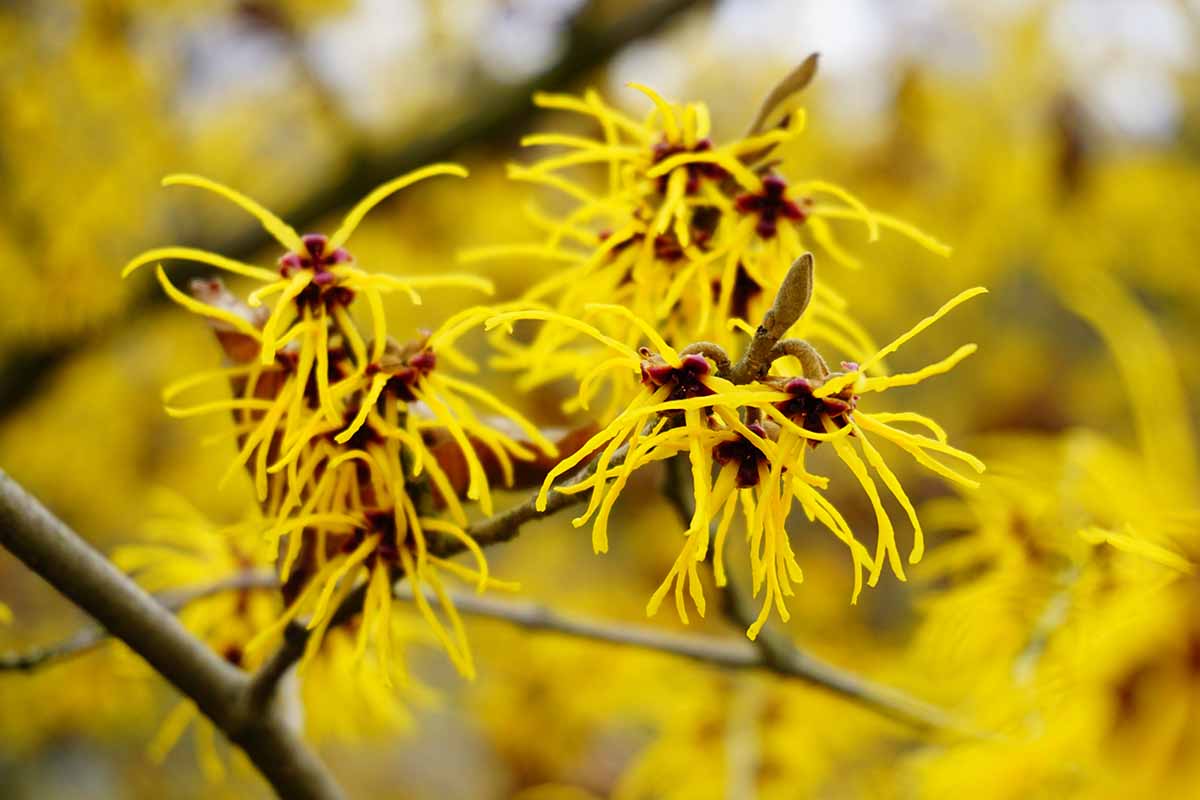
The name Hamamelis actually comes from the Greek words hama and melon, meaning “with” and “apple.” This refers to the way fall-flowering witch hazels bear blooms and fruits from the last season’s flowers simultaneously.
Said fruit capsules are a green-yellow to brown hue. They split open upon ripening and explosively propel their shiny black seeds up to 30 feet away!
And let’s not forget about the leaves: alternate, dark green, and oval-shaped, with an obtuse point and shallow, jagged margins. Come fall, the leaves turn a stunning yellow.
Cultivation and History
Even if you aren’t familiar with witch hazel as a plant, you may have used it to treat your skin, or at least seen it in astringent form at your local pharmacy.
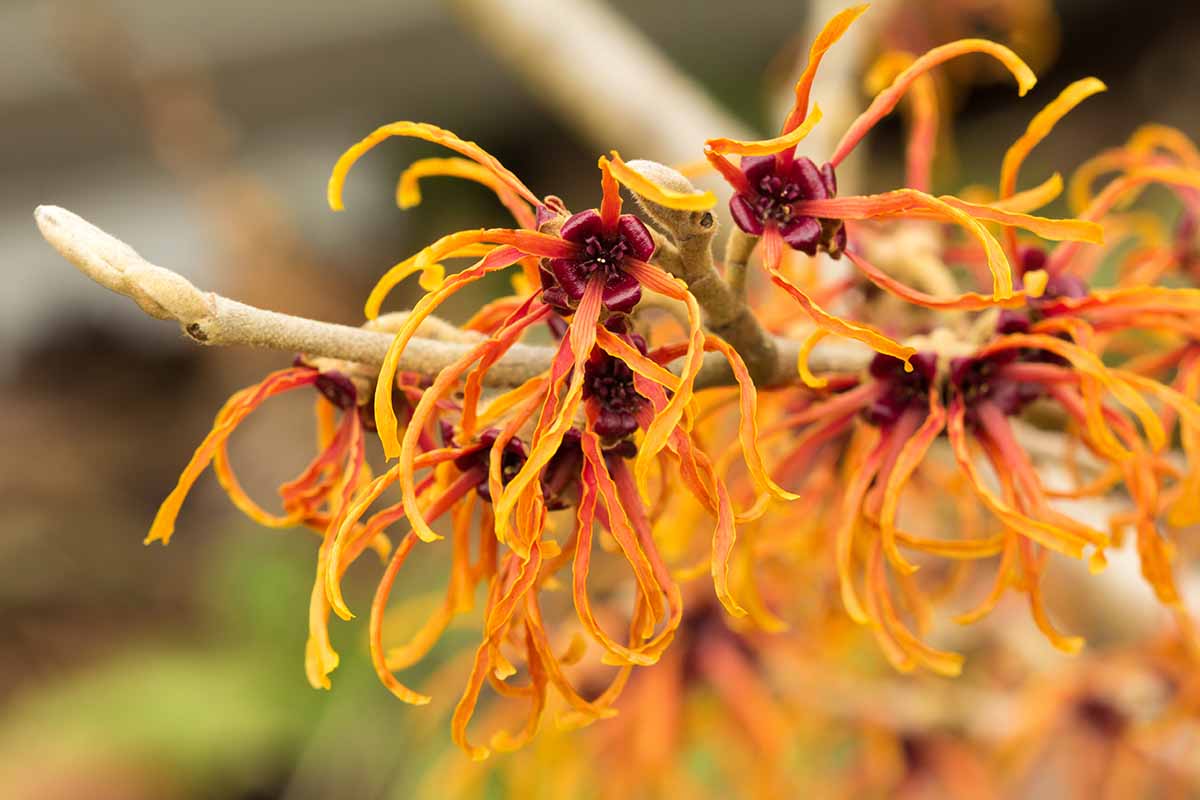
The common name “witch hazel” comes from the plant’s use in water divination.
Native Americans and early settlers alike used forked or bent Hamamelis branches to detect underground sources of water – a process known as “water-witching,” hence the name.
Either that, or it’s derived from old English wice or wiche, meaning “pliable” or “flexible.”
Native Americans also utilized Hamamelis to treat skin irritation, inflammation, eye and liver conditions, fevers, and burns. It was applied to the skin as an astringent or a poultice, and even consumed in liquid form as a tea.
European settlers saw witch hazel’s potential, and adopted its use as a medicinal tea themselves.
In 1846, the American pharmacist Theron T. Pond invented a remedy that would later become Pond’s Extract, a popular product that helped to repair and strengthen skin.
In 1866, a man named Thomas Newton Dickinson founded the first commercial witch hazel extract distillery in Essex, Connecticut.
Having since moved to East Hampton, Connecticut, the facility is the world’s largest commercial source of witch hazel extract today, which they still produce from wild-harvested New England Hamamelis.
Nowadays, witch hazel can be found in lotions, soaps, ointments, and medicines.
The latter is especially significant, as it is one of the few American medicinal plants approved for use in non-prescription drugs by the U.S. Food and Drug Administration.
And obviously, Hamamelis makes for a fine landscape planting – it’s as soothing on the eyes as it is on the skin.
Propagation
While it is technically possible to propagate witch hazel from seed, by taking cuttings, or via grafting… I wouldn’t recommend it to the average home gardener.
The seeds require a complicated double dormancy period, Hamamelis cuttings are quite difficult to root successfully, and grafting can be pretty tricky to pull off.
Propagating suckers or transplanting are your best options.
From Suckers
A Hamamelis plant will readily put out suckers from its base, which can colonize and transform a single witch hazel into a whole thicket of ’em.
Pruning can help to keep up appearances while leaving you with plenty of baby propagules to work with.
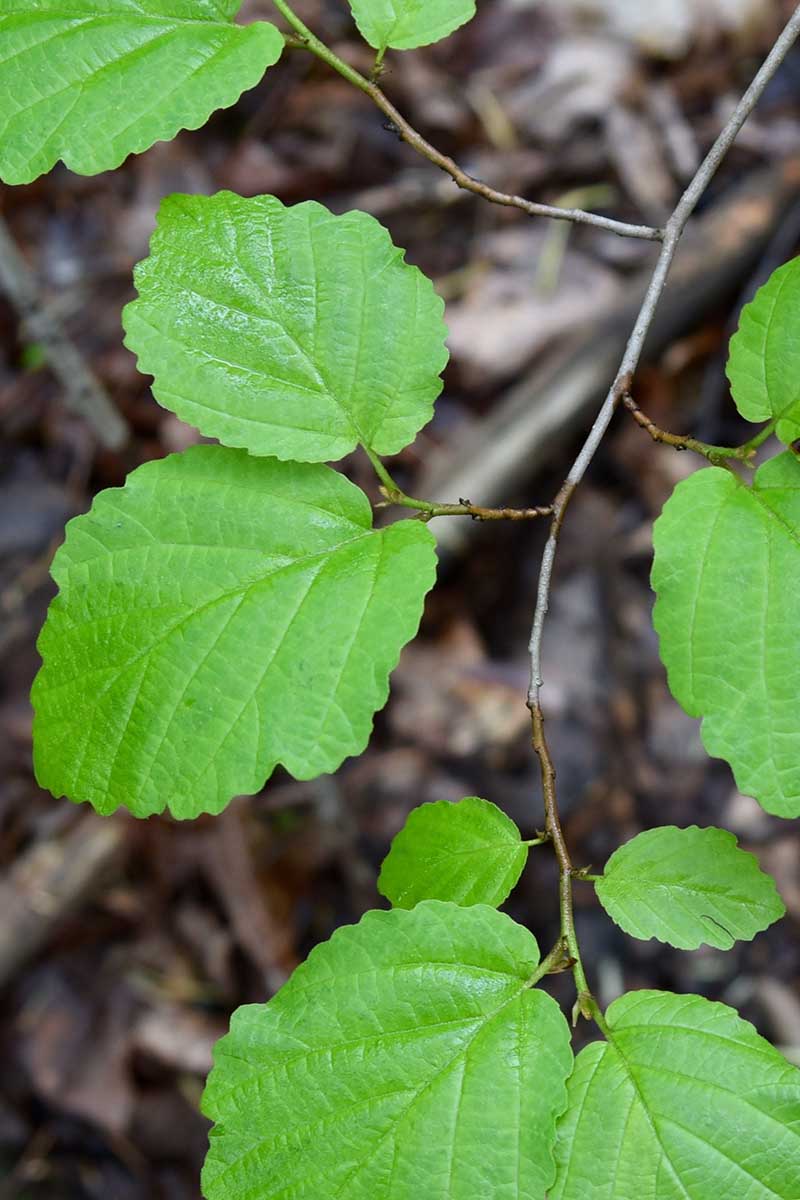
In early spring, carefully dig up and remove suckers from the base of the plant with some roots attached. Be careful to avoid disturbing the roots of the parent plant.
Swiftly transplant the suckers into their intended locations. Keep their mature size in mind and choose appropriate spots for planting.
For a Hamamelis, the ideal planting site is a patch of fertile, well-draining soil situated in full sun to partial shade. Water them in and keep the soil moist.
Via Transplanting
Transplanting established Hamamelis specimens is not recommended, as they don’t like having their roots disturbed. Potted nursery specimens may be transplanted in early spring.
Prepare planting sites situated in full sun to partial shade, with well-draining, fertile, and acidic soil.
Soak the roots of any bare root transplants in water for three to six hours prior to transplanting – don’t let the roots dry out! Be sure to remove any dead or damaged roots.
Dig holes the depth of and a bit wider than the transplants’ root systems.
Lower each transplant into a hole, and spread the roots over cones of soil piled in the bottom. Backfill, tamping the soil down gently as you go. Water deeply and maintain soil moisture.
How to Grow Witch Hazel Plants
Growing witch hazel ain’t witchcraft… but it definitely helps to keep a few pointers in mind.
Climate and Exposure Needs
All plants in the Hamamelis genus are hardy within a range spanning from Zones 3 to 9, but you’ll need to consider the needs of the particular species that you’re planting.
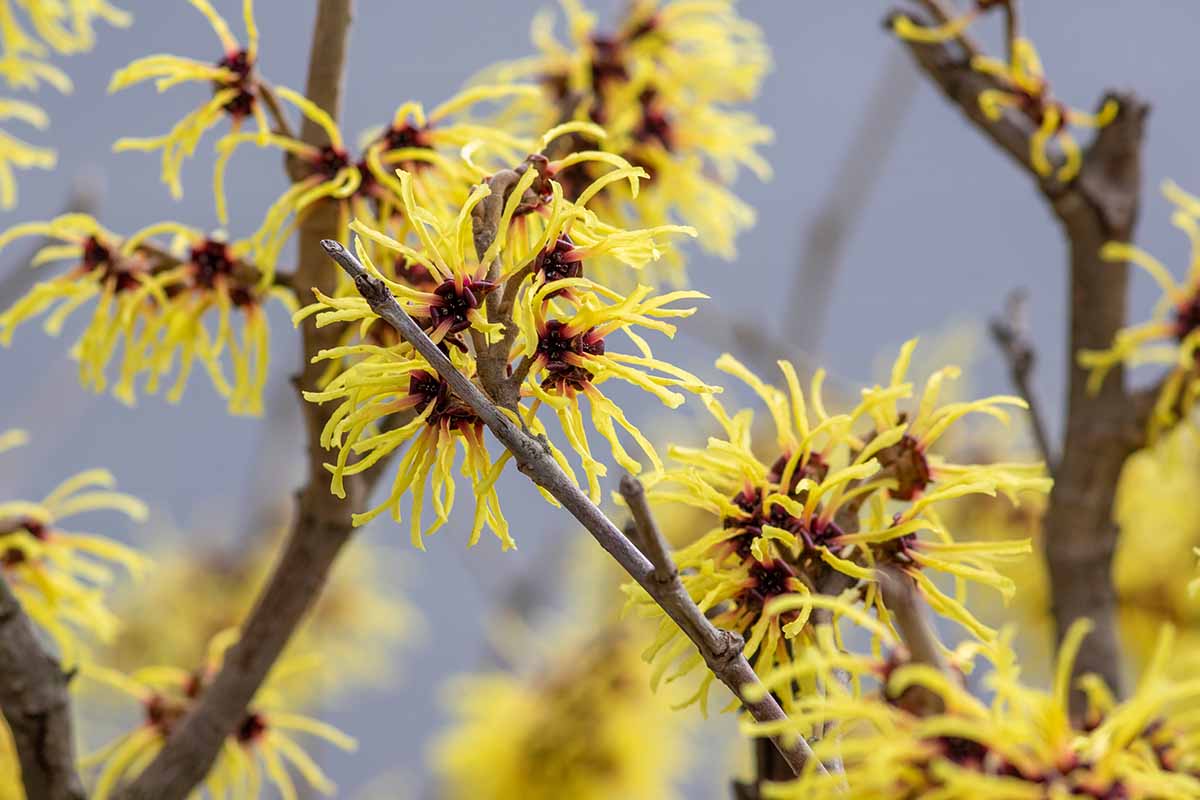
The exposure that you provide will determine how the plant grows, to some extent.
Full sun will result in more flowering and a denser habit, while partial shade will encourage more open branching. But full shade is merely tolerable, and won’t lead to satisfying growth.
Soil Needs
Fertile and well-draining; as long as those two needs are met, you needn’t fret over the exact soil texture required.
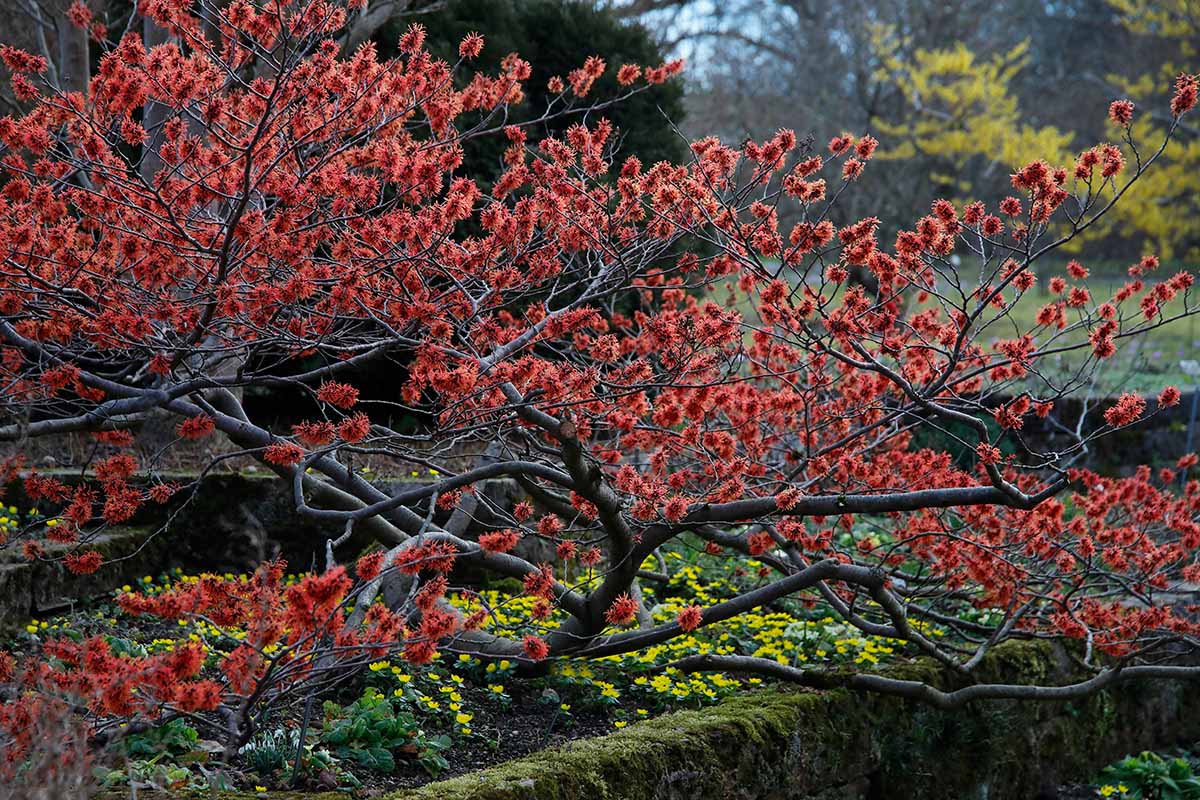
Heck, even clay soils – which are notoriously water-retentive – are tolerated by witch hazels. And they also help to control erosion, so you can feel free to plant on hillsides and slopes.
Witch hazel does best in acidic soil, so shoot for a pH level that’s somewhere between 4.5 and 6.5.
Irrigation and Fertilizer Needs
Witch hazel is resilient in the face of moderate drought, but maintaining a moist soil is optimal. This entails watering whenever the top inch of soil feels dry to the touch.

A top-dressing of balanced, granular, slow-release fertilizer applied to the root zone in early spring should be plenty to keep the soil fertility topped off.
Growing Tips
- Full sun is best for flowering and dense foliage.
- Provide well-draining, fertile soil with a pH of 4.5-6.5.
- Irrigate whenever the top inch of soil dries out.
Pruning and Maintenance
Pruning away suckers at their base, along with any crossing, rubbing, or misdirected branches, is a smart decision.
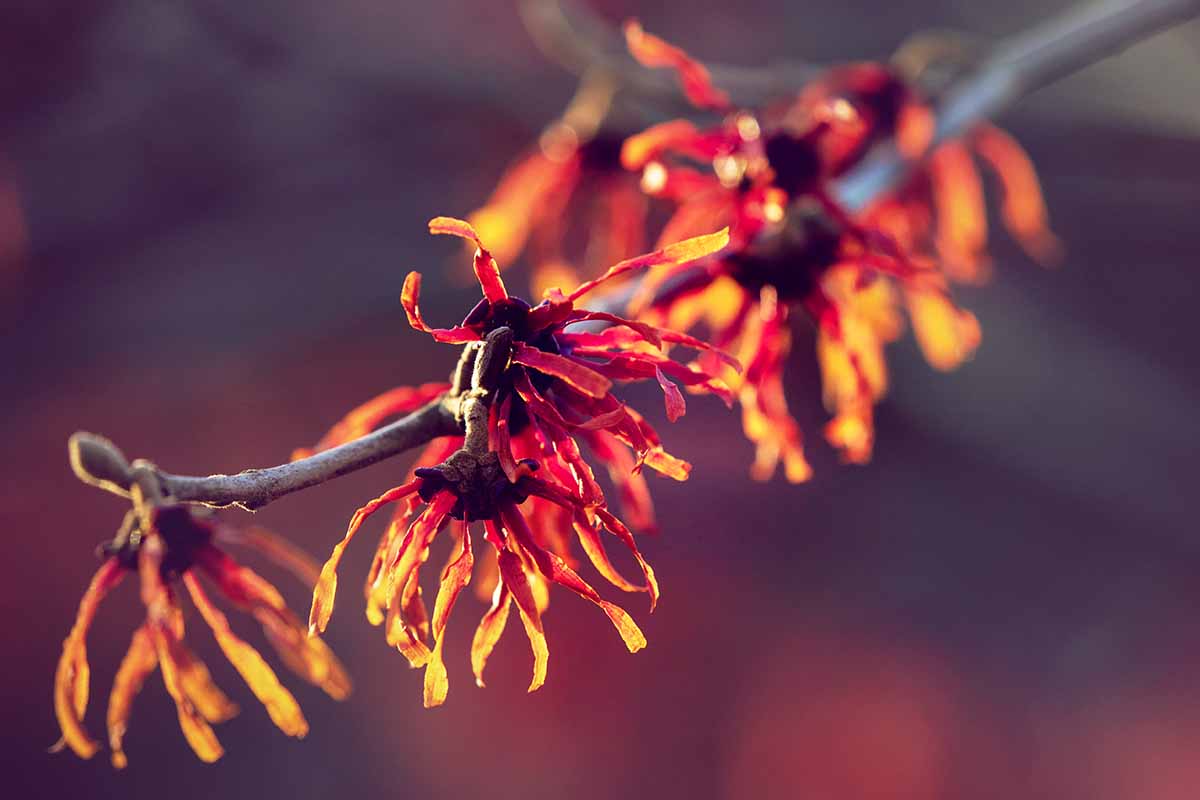
Prune annually in early spring, and don’t remove more than a third of the plant in one go. Damaged, dead, or diseased branches can be pruned whenever you happen to see them.
As far as form-shaping goes, you don’t have much to worry about. Simply letting a witch hazel its own thing, growth habit-wise, will leave you with a pleasing natural shape to be proud of.
To conserve soil moisture and suppress nearby weed growth, keep a two- to four-inch layer of mulch around the root zone of your Hamamelis. Shredded bark works just fine.
Species to Select
Since there are only five species within the Hamamelis genus – all of them worth planting, especially if they’re native to your local area – the completionist in me thought it best to cover them all here.
I’ve also included a hybrid that acts as a gateway witch hazel, responsible for a plethora of awesome cultivars.
Big Leaf
H. ovalis is actually a fairly recent and unexpected discovery.
Back in the summer of 2004, areas of Camp Shelby – a US military post and training facility located in southern Mississippi – were proposed for tracked vehicle maneuvering.
During surveys of these areas, a colony of unusual-looking witch hazels with rather large leaves was observed.
Follow-up surveys confirmed that these specimens were indeed different from other Hamamelis in the Gulf Coast region, and boom: a new species was discovered!
Reaching heights of 15 feet, this shrub has leaves that are about four to eight inches in length, and two to six inches in width. Said leaves are oval-shaped and dark green, with hairy and pale undersides.
Hardy in USDA Zones 6 through 9, big leaf witch hazel blooms from late December to early January, with each particularly fragrant flower bursting with red, ribbon-like petals.
If you’re interested in a rare Hamamelis with big ol’ leaves, H. ovalis is the obvious choice.
Common
“Common” ain’t always a bad thing… especially not in the case of H. virginiana.
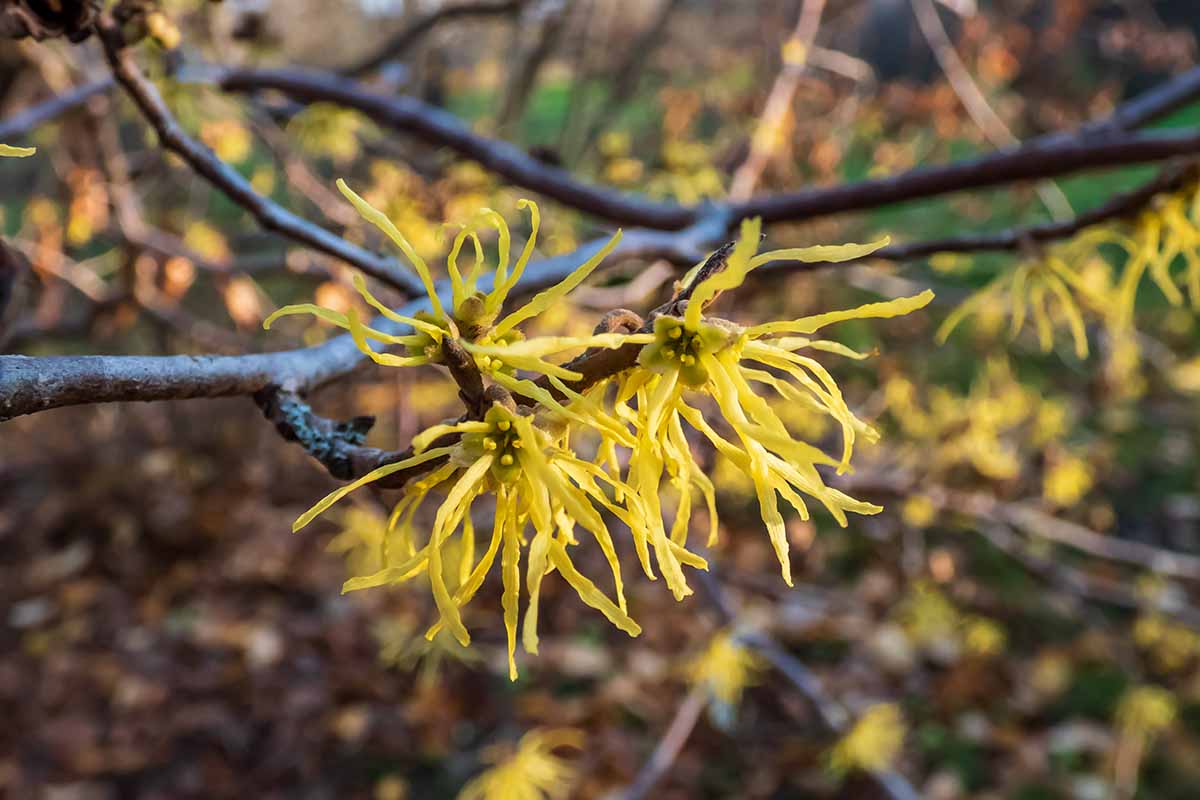
Native across the eastern United States and typically reaching a height and spread of 15 to 20 feet in cultivation, common witch hazel blooms with fragrant, yellow-petaled flowers between late October and early December.
With a large hardiness range spanning Zones 3 to 9 and a beautiful autumnal barrage of yellow foliage prior to the appearance of the blooms, common witch hazel is popular for a reason.
You can purchase a two- to three-foot bare root specimen now from Nature Hills Nursery.
Chinese
Hailing from central China and hardy to Zones 5 through 8, H. mollis reaches heights and widths of 10 to 15 feet, blooming from February to March.

With foliage that appears almost perfectly rounded, the shrub flaunts yellow blooms similar to that of H. virginiana, but in an especially fragrant and compact package.
Hybrid
A vigorous cross of H. mollis and H. virginiana, Hammamelis x intermedia is a one-stop shop of awesome witch hazel cultivars.
With bloom times in the January-to-March range, these are typically hardy to USDA Zones 5 through 8, and generally attain heights and widths of 12 to 20 feet.
You can find plants with a ton of different bloom options derived from this hybrid species, depending on the look that you’re going for.
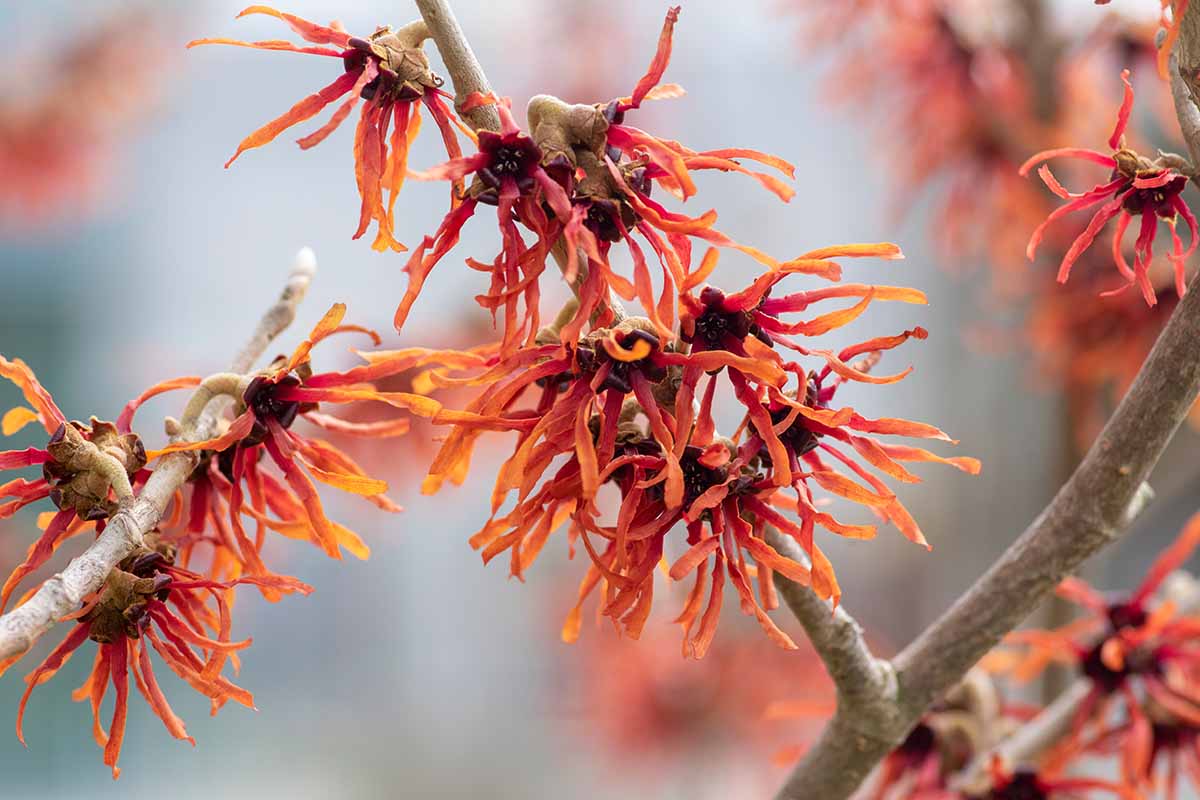
You could even mix and match a bunch of different cultivars to turn your landscape into a living museum of hybrid witch hazels.
‘Arnold’s Promise’ has large yellow petals and an orange fall color.
‘Diane’ blooms with copper-red flowers and has ruby red fall foliage with purple-green margins.
And let’s not leave out ‘Jelena,’ a cultivar with yellow, orange, and red blooms and autumn foliage featuring a gradient of lime green, yellow, orange, and red.
If you’re interested, ‘Arnold’s Promise,’ ‘Diane,’ and ‘Jelena’ are all available from FastGrowingTrees.com in a starter size of one to two feet.
Japanese
A Japanese native that reaches a mature height and spread of 10 to 15 feet, Japanese witch hazel explodes with narrow yellow flowers from February to March, and has attractive green foliage that yellows in autumn.

Hardy in USDA Zones 5 to 8, H. japonica appears wider-spreading than other witch hazels, with a more open and almost flat-topped branching habit.
This beautiful habit differentiates the shrub from other kinds of Hamamelis, much like the natural-looking form of a Japanese maple sets it apart from other species of Acer.
Vernal
In some ways, vernal witch hazel is the opposite of its common relative.
Instead of producing all-yellow flowers that emerge in fall, H. vernalis blooms can also be red and/or orange, and these flower from January through March.

While H. virginiana has an irregularly-shaped and open crown, the habit of H. vernalis is densely-packed and neat in appearance.
Native to the south central US, its range spans Missouri, Arkansas, Texas, Oklahoma, and Louisiana.
Hardy in Zones 4 to 8 and reaching a height of six to 15 feet, vernal witch hazel makes for a beautiful screen, especially when you have a line of ’em.
Managing Pests and Disease
Since we’ve now covered the ornamental greatness of witch hazels at length, hopefully you’re now inspired to protect them from the pests and pathogens that would seek to do them harm.
Insects
Pest management is an important part of disease prevention, since insects often vector pathogens as they feed. But don’t get it twisted: bugs can cause problems all on their lonesomes, no sickness required.
Gall Aphids
Whether it’s Hamamelistes spinosus or Hormaphis hamamelidis infesting your plants, witch hazel gall aphids (WHGAs) are fascinating pests.
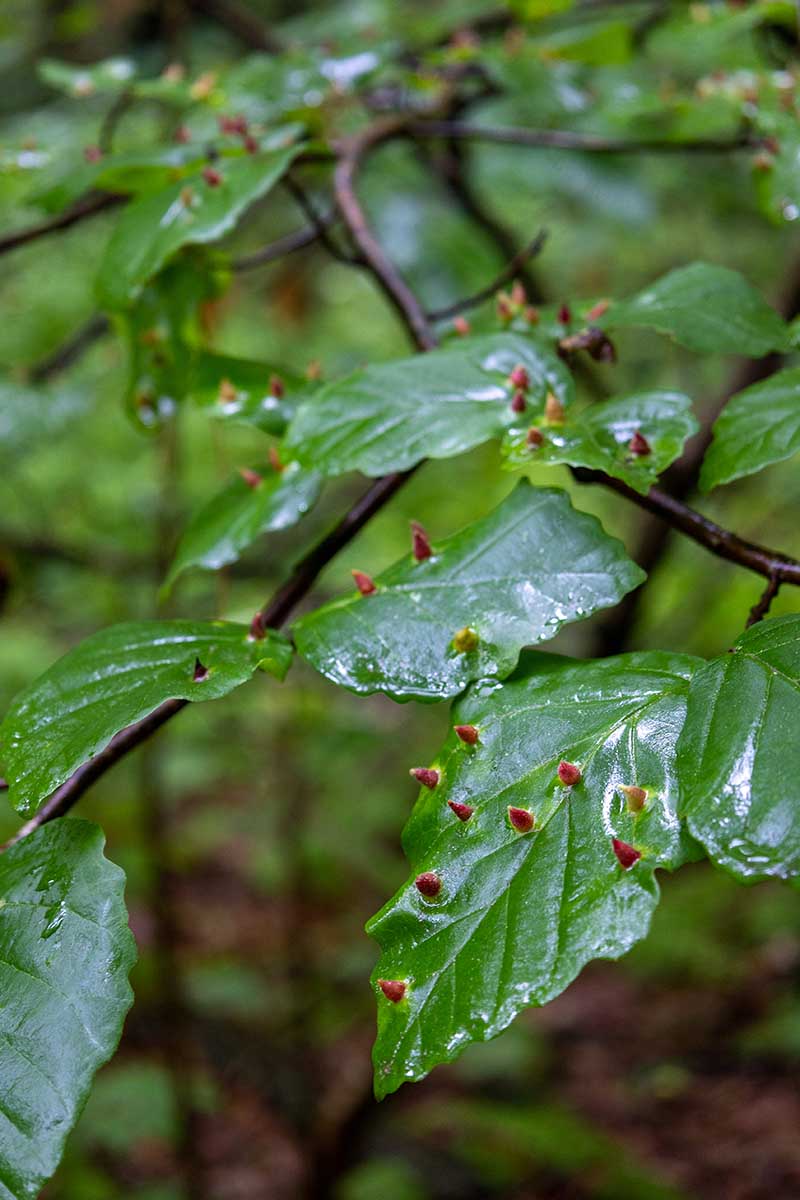
With two-generational life cycles that alternate generations between witch hazels and birch trees, WHGAs induce infested Hamamelis plants to develop cone-shaped or spiny galls on their leaves.
Within these galls, WHGAs feed, reproduce, and continue onto the next life stage. The galls don’t seriously harm plants, but they can be a cosmetic nuisance.
Sprays of insecticidal soaps or horticultural oil in spring will control the active pests, while winter applications will smother any laid eggs.
Since Hamamelis species are deciduous, they’ll eventually drop the afflicted leaves – which you should promptly remove and dispose of – and replace them with fresh ones.

For your aphid-spraying pleasure, Monterey sells horticultural oil concentrate in 32-ounce containers via Amazon.
Japanese Beetles
As an invasive pest, Popillia japonica wreaks a particular kind of havoc.
Feeding on the aboveground tissues of more than 300 different species of plants, adult Japanese beetles are easily recognizable, with their metallic green heads and thoraxes, along with their coppery-brown wing covers.
By eating chunks out of a witch hazel’s leaves, photosynthesis is slowed and aesthetics are reduced – both of which are problematic.
These foliage-munching fiends can be controlled with physical removal and immediate disposal into a bucket of soapy water… or “soapy death,” as past coworkers have called it.
Evening and morning are the best times to strike, when they’re moving more slowly.
For a more aggressive approach, you could apply an insecticide.
Try an organic insecticide with botanically-derived pyrethrins, such as PyGanic Gardening solution from Arbico Organics.
Disease
Sanitized tools, clean soil, pathogen-free plant stock – all essential tools in the gardener’s toolbox.
That, and cultivating your plants properly, since a healthy specimen is more robust when faced with infection.
Phyllosticta Leaf Blotch
Caused by Phyllosticta hamamelidis, this disease results in small, circular, and darkened foliar spots, which can eventually merge into large blotches of necrotic leaf tissue.
Infected leaves may die if the infection becomes severe, leaving plants looking less than lush.
Since the fungus overwinters on leaf detritus as well as infected foliage, any fallen leaves should be immediately raked up and disposed of.
Infected leaves should be removed as you notice them, while pruning to allow for more sun exposure and airflow can reduce disease pressure.
Fungicides are rarely needed, but preventative spring applications of copper hydroxide, mancozeb, or propiconazole can be helpful.
Powdery Mildew
Showing up on infected leaves as a light-colored fungal powder, powdery mildew can lead to leaf distortion, chlorosis, or even necrosis, given time.
Proper plant spacing and avoiding overhead irrigation will both help to prevent powdery mildew.
If only a few leaves are infected, you can remove them. For more severe cases, you should remove infected stems in their entirety and any fallen leaves.
Dispose of them in the trash, not on your compost pile. Pruning away suckers from infected plants will help prevent further spread as well.
Fungicides applied ASAP can help in the case of severe infection… but you can also wait for the infected foliage to drop, clean up the planting area thoroughly, then reassess the following year.
Learn more about powdery mildew in our guide.
Best Uses for Witch Hazel Shrubs
A gardener who’s aware of projected bloom times and plants accordingly can end up with a garden that flowers on a gorgeously choreographed schedule.
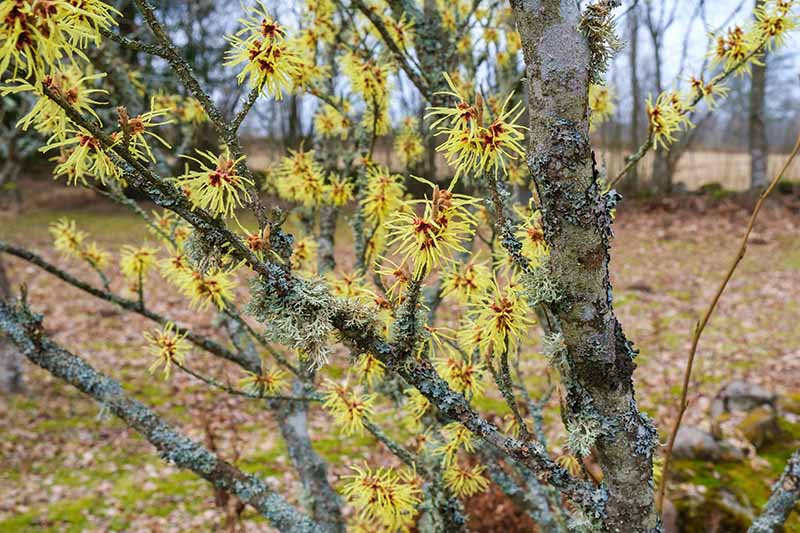
As a very-early-blooming shrub (or late-blooming, in the case of H. virginiana), a witch hazel can kick off your growing season (or put a beautiful bow on it!) with some epic flowers.
And let’s not forget about the lovely fall foliage.
Depending on the species, a Hamamelis can make for a fantastic screen, hedge, specimen, border, or member of a woodland garden.
You could try your hand at utilizing witch hazel for its medicinal properties, or even clip some branches for forcing indoor blooms during winter!
Quick Reference Growing Guide
| Plant Type: | Deciduous landscape tree or woody shrub | Flower/Foliage Color: | Yellow to brownish-red/dark green |
| Native to: | China, Japan, North America | Water Needs: | Moderate |
| Hardiness (USDA Zones): | 3-9 | Maintenance: | Low |
| Bloom Time: | Late winter to early spring or fall | Tolerance | Clay soil, deer, drought (moderate), erosion, deep shade, salt |
| Exposure: | Full sun to partial shade | Soil Type: | Fertile, moist |
| Time to Maturity: | 2-3 years | Soil pH: | 4.5-6.5 |
| Spacing: | Width of mature spread or greater | Soil Drainage: | Well-draining |
| Planting Depth: | Depth of root system (transplants) | Attracts: | Birds, insect pollinators |
| Height: | 6-20 feet | Uses: | Early/late flowering, medicinal, screen/hedge, shrub border, specimen, woodland garden |
| Spread: | 6-20 feet | Family: | Hamamelidaceae |
| Growth Rate: | Slow to moderate | Genus: | Hamamelis |
| Common Pests and Diseases: | Japanese beetles, witch hazel gall aphids; Phyllosticta leaf blotch, powdery mildew | Species: | Japonica, mollis, ovalis, vernalis, virginiana |
Don’t Dismiss Hamamelis
Knowing at least a little bit about a ton of awesome plants comes with a notable disadvantage: paralysis by analysis.
With so many amazing options, how can a gardener decide which to plant first?
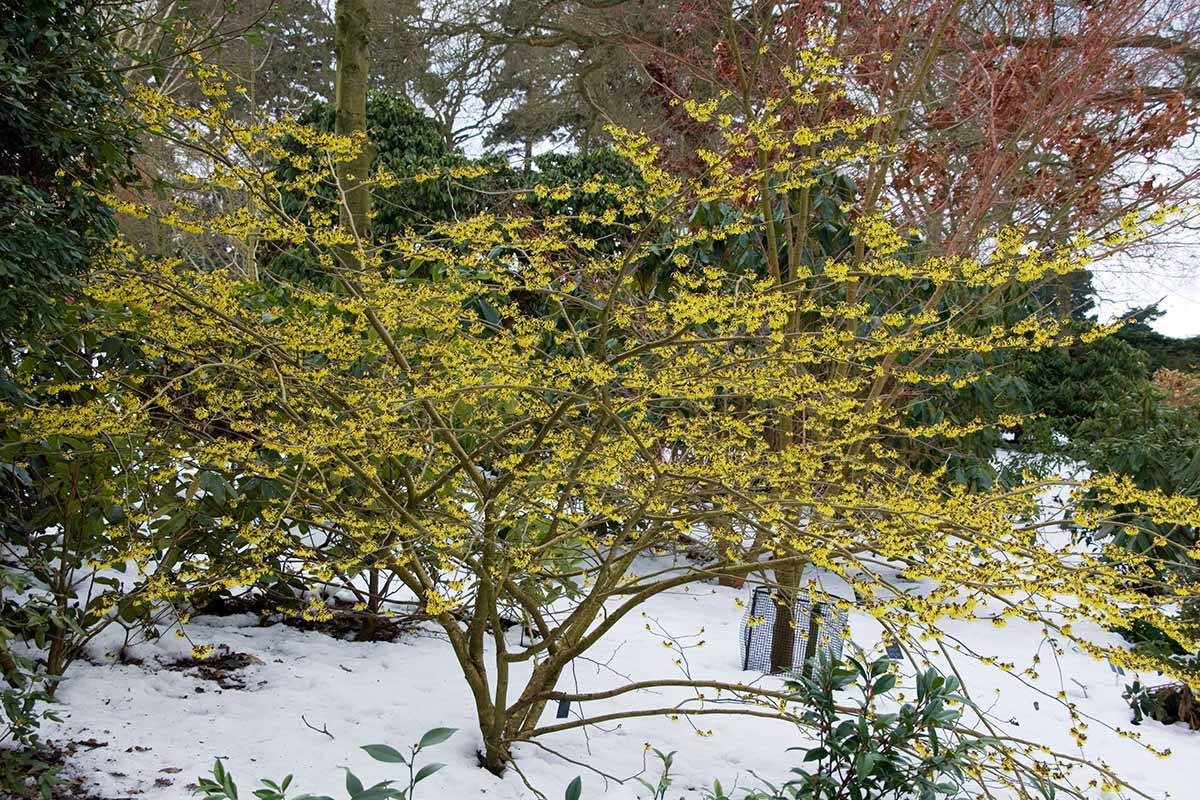
If you need an outside force to tell you what to do, I’ve got you covered: pick a witch hazel. Seriously, put it at the top of your planting to-do list. You’ll thank me later.
Now that you can grow these shrubs for yourself, have fun learning the ins and outs of their care. Some stuff can only be learned in the trenches.
Are you growing witch hazel? Let us know in the comments section below!
For other shrub selections that offer beautiful color and blooms, give these guys a go next:
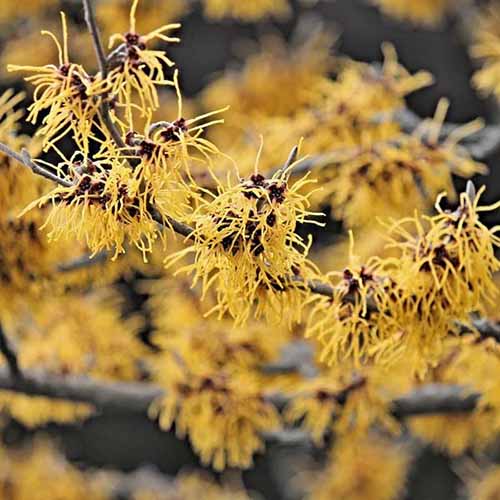

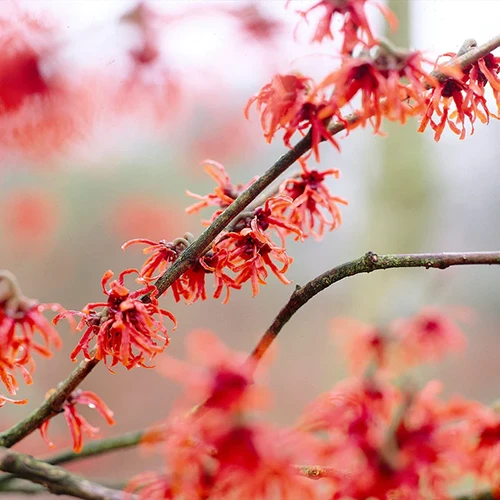
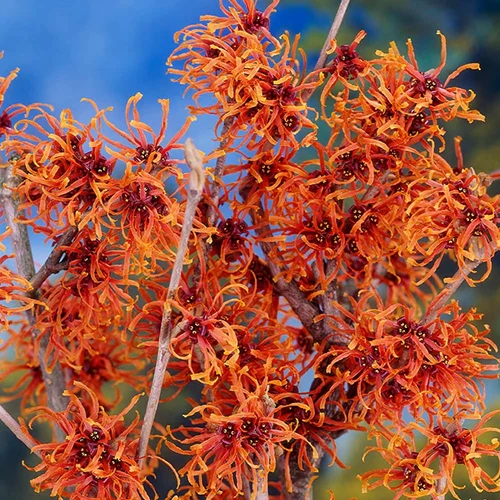
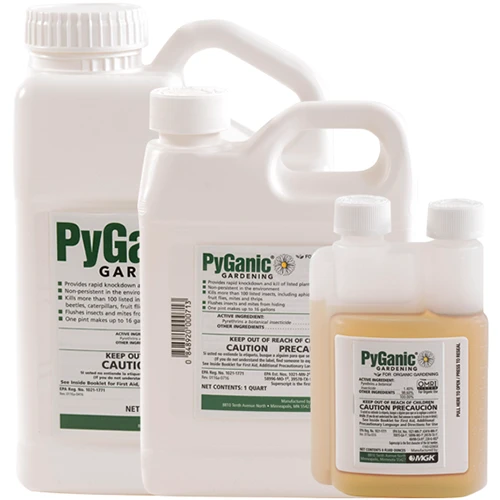
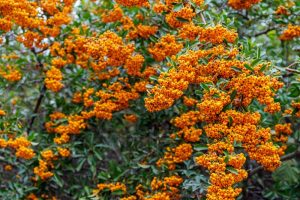

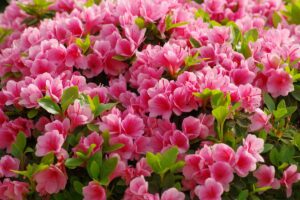
I love my witch hazel trees. The bronze/red one begins to flower in early January and the yellow one toward the end of January. They are growing in containers in what is a small garden. Winter is a lot less gloomy with them in flower. And as you say, the autumn colour is also beautiful. Just looking to find out if I should prune what appear to be suckers, and if so, when?
Glad to hear from a fellow witch hazel fan, Elizabeth!
In my opinion, trees look better without their suckers. Plus, said suckers are energy sinks and potentially vulnerable spots for pests and pathogens to exploit, especially since they’re low enough to be damaged by mowers and string trimmers. So yes, I’d prune away suckers whenever you happen to notice them.
Hi Joe. Fellow MU grad here, living in Camden Co MO. I have a 12 yo ozark witch hazel that is almost 10 feet tall. Which was unexpected. I planted it outside my windows so I could see the winter blooms and it doesn’t disappoint. I’m going to trim the trees around it so it gets more sun. I will try pruning next spring prior to leaf out. I found your article very informative. Thanks.
Glad you liked the article, Georganne! M-I-Z!